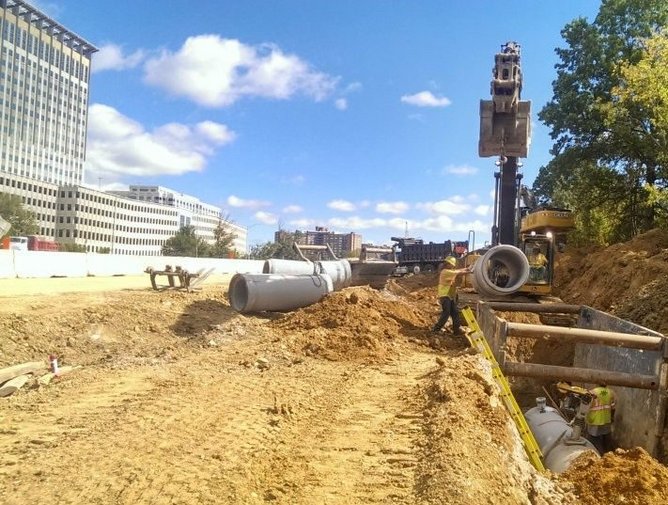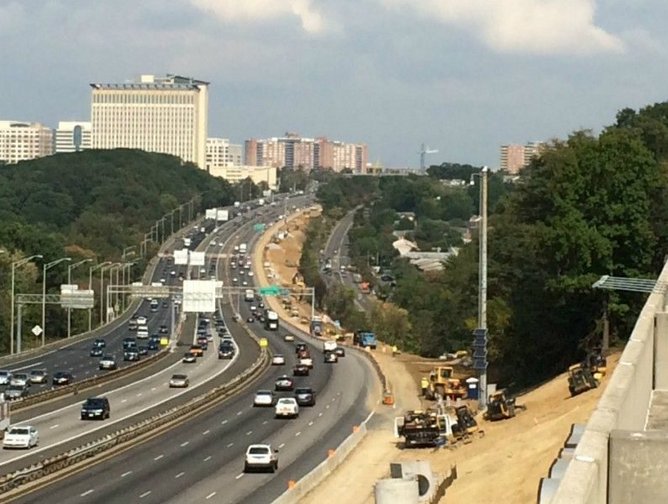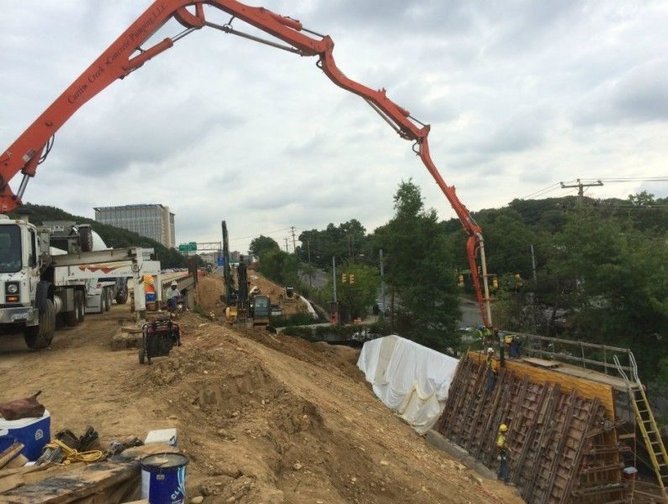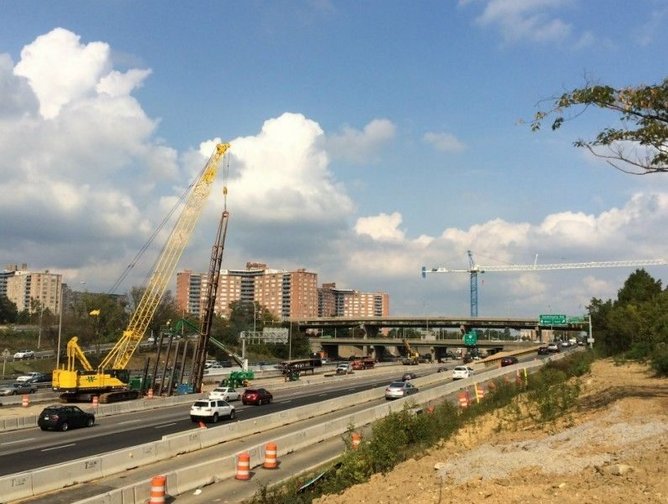Archer Western Construction Brings New I-395 HOV Ramp and Auxiliary Lane to the City of Alexandria
The Virginia Department of Transportation, VDOT, has recently begun construction work on northbound I-395 between Duke Street and Seminary Road in the City of Alexandria, Virginia. This $56 million project includes two capacity improvements: an additional $9 million northbound auxiliary lane connecting the northbound on ramp at Duke Street to the northbound off-ramp at Seminary Road, and a $47 million reversible High Occupancy Vehicle ramp that will provide improved I-395 traffic flow. After reviewing Statements of Qualifications from seven construction teams, VDOT shortlisted the three best teams and then subsequently awarded the project to Archer Western Construction (a subsidiary of the Walsh Group). The Archer Western Design Build bid was not only the low price but also the proposal receiving the highest technical score.
Going Beyond Expectations
When Archer Western Area Manager for Maryland DC Virginia, Brian Quinlan (assigned as Design Build Project Manager on the VDOT project), was pricing the project, he saw that what VDOT was asking for was labor intensive and time consuming. The scope of work that VDOT bid out included replacing the concrete deck and rehabilitating the structural steel beams for the existing Seminary Road overpass, which would have included removal of existing lead paint, repairs to excessive age related rust damage, replacement of bearings and joints, and strengthening to accommodate the new HOV ramp connection.
Though Quinlan could have bid according to the original scope, he saw the opportunity for Archer Western and its design engineer, Parsons Transportation Group, to demonstrate their skills and decided to propose an extended scope including all new steel and a more efficient bridge design, which left VDOT extremely impressed.
“What we eventually decided to do as part of our proposal was to provide all new structural steel for the Seminary Road overpass, which not only benefits the structure but also solved the problems addressed [in regards to the lead and rust]. Plus, it allowed us to go to a continuous span bridge design so we didn’t have as many joints in the bridge deck, which is good for long term maintenance,” explains Quinlan. He continues, “That’s why we ended up with the highest technical score. We offered more than required by the VDOT Request For Proposals.”
As part of the reconstruction of the Seminary Road overpass, the project will also include a dedicated 14 foot wide pedestrian bridge, which will double as a bike path, to replace the 4 foot sidewalk that currently exists. This pedestrian bridge will include decorative fencing and lighting, as well as being ADA compliant. It will be much safer than the existing sidewalk that is adjacent to traffic, and overall will be much more user friendly and aesthetically pleasing.
In addition to providing a unique and beneficial design for the job, now that the project has commenced, the original completion deadline for the auxiliary lane has been pushed forward by VDOT to accommodate the anticipated traffic capacity increase in the area due to unrelated traffic work further up the road.
Andy Palahnuk, Archer Western’s Project Manager (assigned as Construction Manager on the VDOT project) explains, “We have two milestones that we have to meet that are worth noting. We have roadwork that’s northbound I-395 where we have to widen the outside lanes. We have an interim date of December 31, 2014, to put traffic on that widening. We’re also constructing the HOV Ramp and reconstructing the Seminary Road Overpass that needs to be opened by September 24th, 2015.”
Palahnuk, and a majority of the construction team, are just coming off of a successful $70 million project that also required accelerated bridge construction techniques, and in fact they completed the project early, so this team has experience working under pressure and has proven that they have what it takes to lead an entire project team through the successful completion of an accelerated project. Because of the schedule demands, Archer Western is working simultaneously from one end of the project to the other in order to beat the milestones that have been established. In addition to a larger workforce and extended work hours, this has created additional opportunities for DBE subcontractors that are being engaged to supplement the Archer Western workforce.
Though the project requires fast paced construction to meet the deadlines VDOT is demanding, safety still comes first. “Safety is very important; we take it as the first responsibility. We have a very vigorous safety program that we follow every day. It was tailored for the job site and includes our subcontractors and anyone who works out on the job,” says Palahnuk.
Technology
The Walsh Group, being one of the largest construction companies in the country, uses modern technology on all of their projects. As an example, one of the interesting devices that VDOT has asked Archer Western to use on the I-395 project is Utility Locator Balls.
These are cutting edge technology devices that are dropped into a pipe trench above an underground utility. Once the utility trench is backfilled and surface restoration is complete, the balls have the ability to communicate to a computer above ground and send info regarding the underlying utility. This includes how many feet down it is, what utility it is, and what type of pipe it is. All guesswork is removed, thus making future identification of utilities below ground convenient, safe, and reliable.
Community Impact and Influence
Though the construction for the I-395 project will take some time and require cooperation and patience from the surrounding community, Archer Western is doing everything they can to make it a smooth transition period while the construction work is underway.
“Our construction has not had a big impact on traffic because we were able to shift the three existing lanes to establish our work zone, while maintaining traffic on all three. When we do have to take lanes on a short term basis we’re taking them at night in off-peak hours. Because of these efforts, we’re really not interfering with the peak traffic flows at all,” says Quinlan.
Long term, with the new fourth lane of traffic there is naturally going to be increased traffic noise, therefore noise barrier walls were included in the scope of the project. As part of the design effort, Parsons analyzed the projected noise levels and presented possible noise barrier wall configurations in compliance with FHWA specifications. Thereafter, a vote from the community resulted in the approval of noise barrier walls along three fourths of the widening. In the area without noise wall, the adjacent residents selected to go with trees and landscaping as the sound barrier, rather than a wall.
VDOT and Archer Western were determined to be good neighbors and to keep the community happy with the project, which will clearly be a part of their lives for years to come. As an example, Quinlan explains, “Andy and his team recently met with residents from the adjacent neighborhood and presented them with the designs for the noise barriers and the landscaping and let them comment on and decide what they liked and didn’t like about the designs. The neighborhoods definitely had a say in the final presentation of the project.”
Overall the I-395 project is scheduled to be completed May of 2016 and is expected to provide improved traffic flow and upgraded pedestrian access in the area and Archer Western Construction anticipates that the project will be another successful one for its portfolio.









